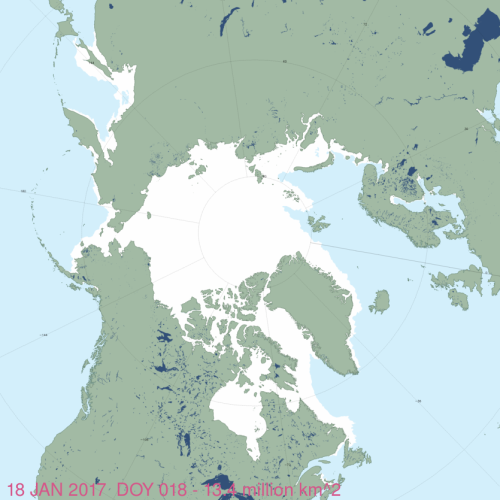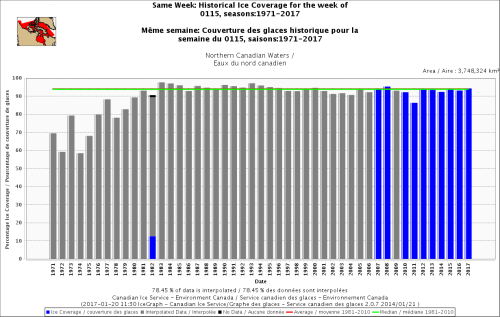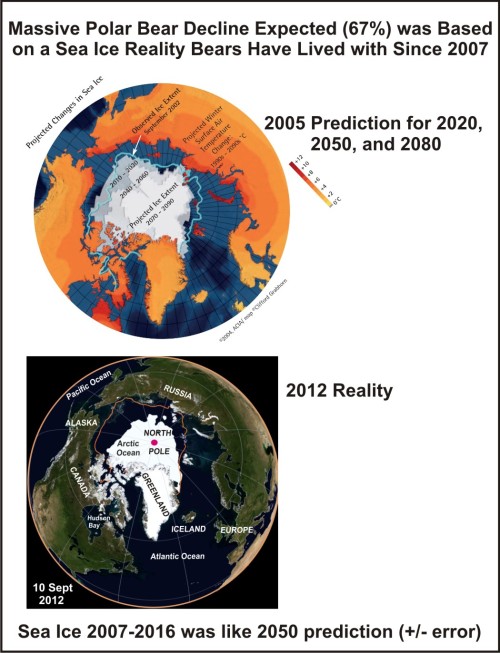Global polar bear population sees ‘significant increase’ – almost 30,000 bears – Up 27% since 2005
By Polar Bear Expert Dr. Susan J. Crockford:
The results of three recently-released studies that were not included in the last IUCN Red List assessment add more than 2,050 bears (on average)1 to the official 2015 global polar bear estimate, a point you won’t likely hear next Monday (27 February) from most polar bear specialists, conservation organizations, their cheerleaders and corporate sponsors on International Polar Bear Day.

This means the adjusted 2015 global estimate for polar bears should be about 28,500 (average), a significant increase over the official estimate of 26,500 (average) for 2015 — and an even larger increase over the 2005 estimate of about 22,500 (average)2, despite the dramatic loss of summer sea ice since 2007 that we hear about endlessly.
It is increasingly obvious that polar bears are thriving despite having lived through summer sea ice levels not predicted to occur until 2050 – levels of sea ice that experts said would wipe out 2/3 of the world’s polar bears (Amstrup et al. 2007; Crockford 2017a, b).
So when you hear, “Save the polar bears, their future is grim” next week, remember that polar bears are thriving right now because those future predictions were flawed: summer sea ice is not critical habitat for polar bears. Instead of a vacuous “vanishing species” polar bear T-shirt from WWF, buy Polar Bear Facts and Myths for the kids in your life – and Polar Bears: Outstanding Survivors of Climate Change for your home or community library. You’ll be glad you did.
Footnotes:
1. Total for all three estimate increases is 2054, or about 2050.
Barents Sea (BS) estimated at 3749 for entire region, up 42% (1109) since 2004 estimate of 2640, based on 42% Svalbard increase determined in 2015 (Norwegian Polar Institute 2015; Crockford 2017b) applied across the region. This is consistent with observations in 2004 that researchers found about three times (2.87) as many bears in the Russian sector than in Svalbard (Aars et al. 2009), and the stated expectation by Norwegian biologists that the population size would continue to increase despite declines in sea ice (Fauchald et al. 2014).
Baffin Bay (BB) estimate 2,826 (95% CI = 2,059-3,593) at 2013 (SWG 2016), up 752.
Kane Basin (KB) estimate 357 (95% CI: 221 – 493) at 2013 (SWG 2016), up 193.
2. USGS polar bear biologists (Amstrup …
Polar bear habitat update: Masie charts show more ice in 2017 than 2006
Polar bear habitat update: Masie charts show more ice in 2017 than 2006
It’s just an observation but NSIDC Masie ice charts show 14.7 mkm2 of sea ice for 2017 at 19 February (Day 50) but only 14.3 mkm2 for 2006 (see them copied below). In contrast, the NSIDC interactive graph shows almost the opposite: 14.3 mkm2 for 2017 and 14.4 mkm2 for 2006 (but with both below 2 standard deviations of average). Different treatment of ice concentration values probably account for much of the differences and it doesn’t mean much. But it needs to be pointed out while sea ice is lower than average this year, sea ice coverage was also below average in 2006 – and there was not a huge die-off of polar bears that year as a result. There is no evidence that polar bears require “X” amount of sea ice in late winter or spring. Anyone who suggests otherwise is making things up. Here is Masie 2017 for day 50 (cropped), 14.7 mkm2: Below is Masie 2006 for day 50 (cropped), 14.3 mkm2:
— gReader Pro…
Polar Bear Numbers Still On The Rise, Despite ‘Global Warming’

Polar bear populations are still growing despite global warming, according to new research. The new population estimates from the 2016 Scientific Working Group are somewhere between 22,633 to 32,257 bears, which is a net increase from the 2015 number of 22,000 to 31,000. The current population numbers are a sharp increase from 2005’s, which stated only 20,000 to 25,000 bears remained — those numbers were a major increase from estimates that only 8,000 to 10,000 bears remained in the late 1960s. Scientists are increasingly realizing that polar bears are much more resilient to changing levels of sea ice than environmentalists previously believed, and numerous healthy populations are thriving. –Andrew Follett, The Daily Caller, 16 February 2017
1) Polar Bear Numbers Still On The Rise, Despite Global Warming
The Daily Caller, 16 February 2017
2) It’s Official: Polar Bear Numbers Continue To Rise
Polar Bear Science, 15 February 2017
3) Bates, Burgers & The Scientific Integrity Of NOAA
Toad Liquor, 14 February 2017
4) Kimberley Strassel: Don’t Wimp Out On Climate
The Wall Street Journal, 17 February 2017
5) Francis Menton: Are Climate Alarmists Glassy-Eyed Cultists?
Manhattan Contrarian, 17 February 2017
The new BB and KB subpopulation estimates should increase the 2015 global population size estimate issued in 2015 by the IUCN Red List from 22,000-31,000 to 22,633-32,257 which would likely be rounded off to 22,500-32,000. But wait! That estimate does not include a reported 42% increase in the Svalbard portion of the Barents Sea subpopulation in late 2015 that was not included in the Red List assessment of 2644 based on 2004 data. Therefore, when the Svalbard increase and the Baffin Bay/Kane Basin increases are all added to the 2015 Red List estimate, it might give a revised 2015 global estimate of something like 23,000-33,000 depending on how all the results are interpreted. –Susan Crockford, Polar Bear Science, 15 February 2017
Rose is not the story. Bates is not the story. The story is the circumvention of procedures put in place to protect the integrity of the data, and hence the reputation of the NOAA. No, the issues are as Bates outlined: “Ethical standards must be maintained”. There can be no confidence in data without confidence in the procedures surrounding collection and storage of data. And persons or organizations that place no value in these procedures further erode confidence. —Toad Liquor, 14 February 2017
President Trump will
Analysis: US biologist’s defense of flawed polar bear predictions is an embarrassment to science
US biologist’s defense of flawed polar bear predictions is an embarrassment to science
A few days ago in a radio interview, a senior US Fish & Wildlife biologist repeated the tall tale that Southern Beaufort Sea polar bear numbers declined in recent years due to loss of summer sea ice. But restating this egregious misinformation does not make it true. The Southern Beaufort population did decline between 2001 and 2006 but it was due to natural causes (thick ice in spring from 2004 to 2006) – it had nothing to do with recent summer sea ice loss and Eric Regehr knows it. There is no evidence that the population decline continued after 2006, so it cannot be said to be still declining. Moreover, the situation in the Southern Beaufort does not support the predictions made by Regehr and his colleagues that polar bear populations will decline precipitously if summer sea ice declines further. My recently published paper demolishes the message of doom for polar bears and the misinformation it’s based upon: it’s free and written in straight-forward scientific language. Crockford, S.J. 2017. Testing the hypothesis that routine sea ice coverage of 3-5 mkm2 results in a greater than 30% decline in population size of polar bears (Ursus maritimus). PeerJ Preprints 19 January 2017. Doi: 10.7287/peerj.preprints.2737v1 Open access. https://peerj.com/preprints/2737/ (pdf here). Here’s an excerpt of the nonsense broadcasted on KNOM Radio Alaska by Regehr and transcribed for their website (29 January 2017) [my bold]: “If there’s a poster child for Arctic animals affected by climate change, it’s the polar bear. … “Putting together all available data, and making some informed projections on the basis of those data, do suggest that there is a high probability that the global population of polar bears could face reductions of up to one-third or greater in the next 35 to 40 years,” said Regehr. One group that’s thriving is the Chukchi Sea subpopulation, which includes Western Alaska and the Russian coast across the water. “The waters are shallow, they’re nutrient rich; there are a lot of seals, ringed seals and bearded seals, out there for the polar bears to eat,” said Regehr. “And so, other studies suggest that, despite the fact that the Chukchi Sea region has exhibited a loss of Arctic sea ice the bears in that region appear to be faring quite well, currently.” But their neighbors to the East, the South …
Arctic Sea Ice Grows Back To 2006 Levels
Sea ice charts for 18 January from NSIDC Masie show exactly as much sea ice in 2017 as there was back in 2006 – 13.4 million km^2.

Masie image below from 2006 (enlarged and cropped from archived version and label re-inserted) shows the distribution of ice was slightly different than this year (less in Baffin Bay/Davis Strait/Labrador Sea, more in the Barents and Bering Seas):

Considering only Canada (where 2/3 of the world’s polar bears live), Canadian Ice Service comparative graphs going back to 1971 show average amounts of ice existed the week of 15 January 2017, but considerably more than the estimates for the 1970s (odd that we never hear about that):
 …
…
Zoologist calls U.S. polar bear survival plan ‘fake news’ as animals thrive
…Polar bear conservation group blasts Obama for climate alarmism: ‘Sensationalized nonsense’
The Obama administration warned Monday that polar bears may disappear unless something is done about climate change, despite recent research indicating that the bears are actually thriving.
In its final Conservation Management Plan, the Fish and Wildlife Service painted a grim picture for the future of the massive Arctic-dwelling mammal, warning that its fate will be determined “by our willingness and ability to address climate change.”
“The current global polar bear population is estimated to be 26,000,” said the FWS press release. “If greenhouse gas emissions continue to rise at the current rates throughout the 21st century, polar bears will likely disappear from much of their present-day range.”
The announcement prompted pushback from zoologist Susan J. Crockford, founder of the Polar Bear Science website, who blasted the service for igniting a rash of “sensationalized nonsense” by fueling alarmist media reports.
Since 2007, “summer sea ice coverage has declined to levels their sea ice colleagues said would not occur until 2050 yet 2/3 of the world’s polar bears did not disappear as [U.S. Geological Service] biologists predicted,” Ms. Crockford said in a post.
The polar bear was listed as threatened in 2008 as a result of declining Arctic sea ice, but its population has proved remarkably resilient, although the Fish and Wildlife Service plan doesn’t mention that, she said.
“They also don’t tell folks that the recent decline in population size recorded for the Southern Beaufort Sea was caused by thick spring sea ice in 2004-2006, not reduced summer sea ice,” said Ms. Crockford, an adjunct professor at the University of Victoria in British Columbia.
The International Union for the Conservation of Nature pegs the polar bear population at between 22,000 and 31,000, which she called “the highest estimate in 50 years.”
Recent studies have shown increases in some of the 19 Arctic polar-bear populations. In 2013, the FWS reported the Chukchi Sea population in Alaska was doing “quite well,” while the Norwegian Polar Institute found in 2015 that the Barents Sea polar bears had risen by 42 percent since 2004.
Meanwhile, wildlife groups criticized the federal plan for failing to mandate large-scale U.S. reductions in greenhouse-gas emissions in order to combat climate change.
“Polar bears are starving and drowning as their sea ice melts away, but this toothless plan shrugs off the one solution that will
Polar Bear Expert: ‘Fake news on polar bear survival predictions is political posturing’
I call this fake news because it’s not news – media headlines around the world today (New York Times, Washington Post, DailyMail) are trumpeting the release of a final version of a draft report released with similar fanfare more than a year ago, announced today by the US Fish & Wildlife Service in the official US government publication, Federal Register.

“Without action on climate change, say goodbye to polar bears” is exactly the kind of sensationalized nonsense I address in my new detailed science book, Polar Bears: Outstanding Survivors of Climate Change (announced here, discussed here).

What the USFWS don’t tell the citizens that pay their salaries (in their Conservation Management Plan or their discussions with the press), is that since 2007 (see images above), summer sea ice coverage has declined to levels their sea ice colleagues said would not occur until 2050 yet 2/3 of the world’s polar bears did not disappear as USGS biolgists predicted (which is what got the bears listed as ‘threatened’ under the ESA). They also don’t tell folks that the recent decline in population size recorded for the Southern Beaufort Sea was caused by thick spring sea ice in 2004-2006, not reduced summer sea ice.
Perhaps it’s not a coincidence that this old hype is being recycled as ‘news’ prior to the inauguration of President-elect Trump? I surmise this based on the New York Times take, which includes this passage:
“Mr. Trump has signaled his intention to withdraw the United States from the Paris climate agreement — an accord the wildlife agency lauded in its report as a positive step toward ensuring the continued existence of polar bears — and he has shown little interest in making emissions reduction a priority. Nor is the price tag that accompanies the recovery plan for the polar bear, about $13 million a year, likely to be greeted with enthusiasm by a Republican-dominated Congress that includes members with no great love for the Endangered Species Act.”
If there is much of substance in this document (pdf here) that differs from the draft (pdf here), it would take a page by page analysis to discover (I discussed an interview with polar bear biologist Mitch Taylor regarding that 2015 draft report here).
However, I see that the Federal Register notice (pg. 2393, pdf here) does quote the …
Polar bear habitat message for the year end: 2016 Arctic ice extent same as 2010
According to NSIDC daily sea ice interactive graph, there was ever so slightly more ice on 31 Dec 2016 than on that date in 2010. However, the corresponding ice maps show just how differently that ice was distributed.

Recall that in 2010, there was no huge die-off of polar bears attributed to reduced amounts of sea ice in the fall (or to reduced ice in summer, for that matter) because there was no catastrophic die-off at all.
NSIDC Masie ice charts show just how different the distribution of ice was in 2010 at 31 December compared to 2016 at the end of the year (2010, Day 365).
Here is 2010 at day 365 (extent 12.9 mkm2):

For some reason, Masie ice images were unavailable for the last day of the year but below is the one for the next day (2017, Day 1), 1 January 2017 (also 12.9 mkm2):

Compared to the 2010 map above, there is much more ice this year in eastern Canada than in 2010, much less in the Barents Sea north of Norway.
Take-home message: Absolute extent numbers don’t tell the whole story about polar bear habitat changes from year to year.
…As Polar Bear Populations Fail To Decline, Message Of Doom Intensifies
In turns out that polar bears are much more resilient to changing levels of sea ice than data collectors assume and the proof is in the current healthy populations everywhere.
If 10 years of summer sea ice levels expected to kill 2/3 of the world’s polar bears by 2050 hasn’t had an impact, why would anyone expect a bit less summer ice will do the job?
The more the polar bears fail to die in droves, the shriller the message from activist polar bear researchers – via willing media megaphones – that the great death of the bears will soon be upon us, just you wait and see!
Some big media guns were out this past week spreading the prophesy of doom fed to them by the polar bear researchers most committed to the “threatened with extinction” narrative: The New York Times, The Atlantic, The Guardian. The desperation is becoming palpable as the public catches on to their epic failure.
In 2007, the sea ice dropped to a level the experts said wouldn’t be reached until mid-century, and since then, it has remained at that low level (about 3-5mkm2, give or take some measuring error). And in 2007, US Geological Survey (USGS) biologists said with absolute confidence that when sea ice levels reached that point, 2/3 of the world’s polar bears would be gone.…

